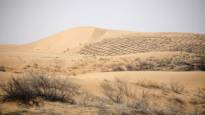China has been one of the worst desertifying countries, but in recent years the deserts have shrunk.
Thousands of square kilometers of land in China turned into desert every year at the end of the 20th century. This resulted in sandstorms and reduced harvests, because almost nothing grew on the sandy dunes.
Now, however, the Chinese Forestry Administration has good news to share: the number of deserts is decreasing. Between 2009 and 2019, the number of deserts decreased by 50,000 square kilometers, reports the news agency Xinhua.
China has been able to rehabilitate more than half of the manageable desertified areas with plantings and erosion prevention techniques, according to the country’s official statistics, according to news agency Reuters.
– China is one of the countries that is highly developed in the fight against desertification, thanks the Secretary General of the UN Convention against Desertification UNCCD Ibrahim Thiaw According to Xinhua.
Sandstorms have decreased, crops have improved
China has returned desertified sandy lands to farmland and planted forest networks to protect them. This has meant 48 million tons more harvest every year, with a monetary value of around 15 billion euros.
An estimated 30 million hectares more farmland has been obtained in the important farming area of northern and northeastern China.
At the same time, sandstorms have decreased by about a quarter.
In comparison, the world loses about 100 million hectares of healthy land every year. In up to 40 percent of the earth’s land area, the vegetation has weakened and the area is either desertified or threatens to become a desert.
The soil is weakened by population growth combined with unsustainable production and consumption methods.
The UN estimates that every euro spent on revitalizing the soil pays for itself 30 times over, for example in improved agricultural productivity.
Decades of hard work
For decades, China has been researching ways to prevent desertification. Since 1978, it has had an extensive afforestation program in the northern part of the country.
For more than 60 years, a technique has been used in which a hard crust is obtained on the sand with the help of a straw grid. Otherwise, the sand would take the planted plants and trees with it. However, the crust has taken ten years to form.
More recently, Chinese researchers have developed techniques that form a crust within a year, for example with the help of cyanobacteria.
Among the innovations there is also a method that can be used to calculate how much forest should be planted in the area so that the water resources are sufficient for the trees.
China says it has also shared its information with other countries. Among other things, Uzbek scientists have collaborated with the Chinese to find ways to improve the condition of the Aral Sea. The lake was once the fourth largest in the world, but has shrunk to less than a tenth of its former size.
On Monday, the UN Day against Drought and Desertification is celebrated.
130 countries have committed to stopping desertification by 2030.
